PASINI REPORTS
Kodak Breaks Into All-in-One Inkjet Market
With Low-Cost Pigment Inks
 By MIKE PASINI
By MIKE PASINIEditor
The Imaging Resource Digital Photography Newsletter
Review Date: March 2007
After three years of top secret development, Kodak today unveiled a new photo printing system designed to make high-volume and quality home printing affordable and simple, according to the company.
Kodak introduced three printers ranging from $149.99 to $299.99, and a revolutionary set of low-cost inks with three basic paper types available in both glossy and matte finishes. The first two printers in the system are expected to be available in March with the fax-capable model available in May.
But rather than sell the razor to make money off the blades, the company is taking a new approach inspired by the frequent-flyer model that rewards more active users. Kodak will consequently sell the printers at full price, relying on an exclusive distribution agreement with Best Buy (in addition to direct sales) to enforce the list price. But it will bundle the ink and paper in packages that deliver print prices as low as 10 cents a print.
To emphasize its new "disruptive" approach, Kodak will display the per-print price on its packaging. That's an industry first, the company said.
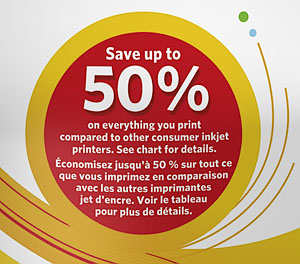
Save 50 Pct. Compared to other systems.
Key to the system is Kodak's new pigment ink system, which can deliver 4x6 prints for as little as 10 cents a print, cheaper than online and discount photofinishers.
Kodak claims that using its inks, you can save up to 50 percent on everything you print. Spending $15 on its color ink yields at least 105 4x6 photos compared to 48 on other systems, the company claims. And spending $10 on its black ink yields 349 pages compared to 145. The 10-cent print can be realized with a Kodak Photo Value Pack, which includes a color cartridge and 180 sheets of Kodak Photo Paper.
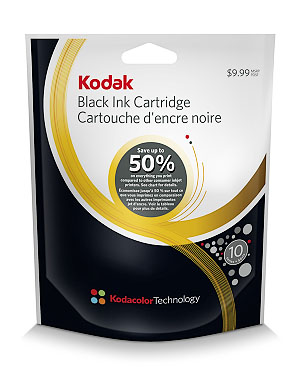
Black Pouch. This rather gray black is used for text printing with the Photo Black from the color cartridge.
Susan H. Tousi, Kodak research and development director for inkjet products, said Kodak drew on pigment grinding patents going back to its film emulsion technology to develop its miniscule 20 nanometer ink pigments with polymer binders. The exceptionally small size of the pigments, she said, accounts for a color gamut that exceeds dye-based inkjets. And, indeed, the test prints we saw included some very saturated images.
And because the inks are pigments instead of dyes, they have a longevity of 100 years, "with no qualification," she added. You don't have to keep them under glass or in the dark to get that 100 years, Tousi explained. They'll remain lightfast for 100 years exposed and unprotected. Kodak has engaged Torrey Pines Research (http://www.tpr.com) to test the lightfastness of the new system, preferring it over Wilhelm Research (http://www.wilhelm-research.com) for its testing of "atmospheric pollutants," she said.

Five Inks. But only four colors -- CMYK -- with K the Photo Black and the fifth ink being a clear coat to match the uninked areas of the print with the inked areas.
The ink system is packaged in two cartridges: a large black cartridge used for text only and a large color cartridge. Kodak counts five inks in the color cartridge, but it's essentially a four-color system. The five inks include the standard Cyan, Magenta and Yellow inks, plus a Photo Black that is also used to enhance standard black text printing. The fifth "ink" in the color cartridge is actually a clear gloss optimizer overlaid on the white or uninked parts of the image to ensure an even gloss to the print. There is no Light Magenta or Light Cyan in the package.
Tousi also showed us the new three-tiered paper line introduced with the printers that makes printer setup automatic. The top two tiers feature a stiff photo print weight, while the least expensive tier is a thinner sheet. All three are coded on the back using gold diagonal lines whose line weight and distance between lines tell the printer what kind of paper it's printing on so you never have to think about it.
All of the papers have a porous surface instead of the swellable gel-coated sheets used by dye-based printers to encapsulate the dyes for longevity. Porous papers dry instantly, because they suck the pigment into the sheet, unlike swellable papers. By using pigment inks on the porous sheet, the prints last much longer than dye-based prints.
Coverage does vary on the different sheets. A tier-one print can be done in 28 seconds, but the higher quality tier-two and three prints require 37 seconds. And cost differs as well. A tier-one print can be done for 10 cents, but a 4x6 tier-two costs 15 cents, and tier-one 25 cents.
THE PRINTERS | Back to Contents
With a permanent printhead using 2.7 and 5.6 picoliter droplets, all three printers in the new Kodak all-in-one line share the same print engine. Tousi confirmed that, as inkjets, you still have to use them regularly to avoid clogging those heads, but thanks to the lower ink costs, flushing them out doesn't hurt your wallet as much.
In addition to the print engine, all three models share the same scanner mechanism and the same built-in paper tray (with a 4x6 cartridge you push in to engage). They also all rely on Kodacolor technology to enhance images automatically.
All of the printers employ a very simple snap-in ink cartridge arrangement that makes it easy to install either cartridge by simply slipping it into the large bay and clicking it into place. It's just as easy to remove a cartridge by pinching the two finger holds together and lifting it out.
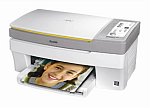
5100. Dual USB for PictBridge and Bluetooth connectivity.
The $149.99 5100 offers just a dual-port USB connection available on the other two models, as well. You can cable a PictBridge-compatible camera to one of the ports or a Bluetooth wireless adapter to print from your Bluetooth camphone, digicam or Bluetooth laptop. We saw very quick text printing and high-quality photo printing via Bluetooth during our visit with Tousi.

5300. Dual USB plus a card reader and 3.0-inch LCD.
The $199.99 5300, which we hope to have here for review next month, adds a card reader to the input options with a large 3.0-inch LCD to review images. Operation was very simple. Insert the card and review the images on the LCD. Press the Print button when you see an image you like, and a borderless print soon pops out of the printer. You can also press the Proofsheet button to print an index of all the images on the card. You then mark the thumbnails you want to print and the layout you want and scan that information back into the printer.
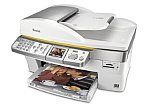
5500. Duplex printing, a document feeder and fax capability with a 2.4-inch LCD.
The top-of-the-line $299.99 5500 adds a document feeder and fax capability to the 5300, and includes a duplexer to print on both sides of a sheet. Kodak plans to make the duplexer available as an option on the other two models as well. The LCD is a little smaller than the 5300's at 2.4 inches, but still generous.
Tousi said the printer will configure itself for a generic photo paper if it detects a non-Kodak photo paper.
None of the models feature a transparency adapter.
Two features worth noting on the scanners are their batch scanning and storage capability.
Tousi told us that you can load the scanner glass with several images and the built-in software will crop and save them individually, straightening them as necessary, after the batch scan.
That feature will tie in to a new version of EasyShare software to ship with the printers, which will be able to archive the scanned images and copy them automatically into an album on EasyShare Gallery, Kodak's online photo-sharing and photofinishing service.
But you can also plug a thumbdrive into the USB port and save the images to the drive, she said. Which is not a bad way to pass on a favorite shot or four from the family album to a visiting grandchild.
COMPARABLES | Back to Contents
In our multifunction printer testing and reviews, we've found the low-end HP all-in-ones and high-end Canon all-in-ones best of breed.
HP's models generally match the Kodak 5100 in features, offering just a USB port at the very low end and, like the 5300, a card reader for a bit more. Cartridge installation and removal has been the one aspect of the HP line that's always been a problem. Otherwise they've performed admirably, offering a wealth of software to tap into the full capabilities of the unit. And they're rather compact units, ideal for dorm rooms or home offices. Prices are significantly lower (you can find a low-end HP for under $100) but replacing the large ink cartridges is not cheap.
At the high end, Canon offers a compelling solution for all those color negatives stashed in shoeboxes piling up in some closet. At $400, the MP960 can make prints directly from those negatives or just scan the frames of those strips to your computer, a more useful function than having a document scanner and fax.
In fact, faxing from an all-in-one is generally inefficient. If you generate documents on your computer, its more efficient to use the often built-in software of your operating system to fax them. Receiving faxes is easier on the computer too, allowing you to review them without having to print them and to archive them on your system.
But these current best-of-breeds all suffer in comparison to the new Kodaks when it comes to ink usage. We were impressed with the quality of the prints we saw during our visit with Tousi and the performance of the 5300 printer itself. We look forward to comparing prints from the Kodak four-color system to identical images from six- and eight-ink dye-based systems.
Multifunction printers are the top sellers in both the United States and Europe. Small 4x6 printers using either dye-sub technology -- like the Canon's SELPHY printers and Kodak's EasyShare docks -- or dye-based inkjets like HP's line of compact printers are treasured task-specific alternatives. But the cost of keeping them supplied often means you print less, not more.
And that's precisely the problem Kodak has tried to address with its new system. According to its own studies, Kodak says over 70 percent of us limit our own printing because of the cost of supplies. And roughly 30 percent of us say we would print more if ink were less expensive.
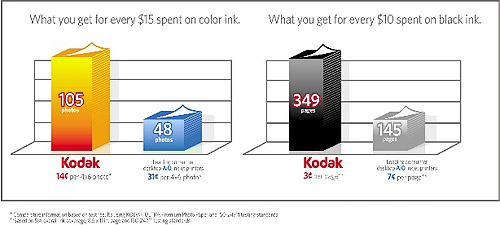
Print Yields. Kodak compares typical inkjet costs to its new system.
With some studies showing that ink costs seven times more than 1985 Dom Perignon champagne, that isn't surprising.
You can get an instantly dry print right now on any inkjet if you just use a porous paper like Kodak's Instant Dry or HP Advanced photo paper instead of a swellable, gel-coated sheet. The problem, however, is that dye-based inks don't last as long on a porous sheet as they do on a swellable sheet.
So Kodak's inks are the real story here. Using a pigment ink on porous paper gives you both instant-dry performance and colorfast longevity. A 20 nanometer pigment means you can spread it thin and keep it bright, Kodak says. And using just four-color printing helps get that 10-cent print.
Our hunch is that the 15-cent print on photo weight paper is going to be the sweet spot, but that's still an excellent price for worry-free 4x6 prints. Stay tuned for our tests next month.